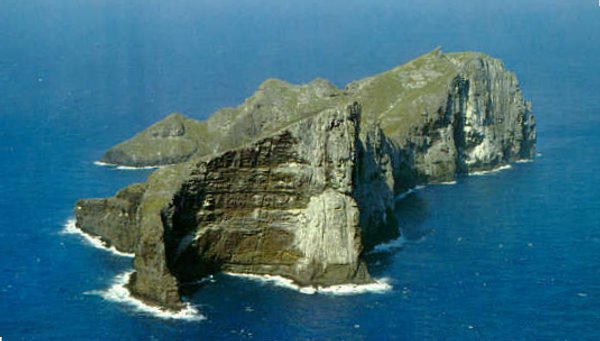Update: I wrote this post without realizing it’s Geography Awareness Week.
I’ve always had a passion for geography and maps. I love to just “read” an atlas, looking at details on maps and trying to imagine what life would be like in remote places. For the longest time, I wanted a globe, and now I have two above my desk (not so I can see both sides of the earth at once, but because they were $1 each at a garage sale). Now, the Google Earth application lets me play with a virtual globe with all the benefits of placemarkers and zooming in to incredible detail (see the KML links below that work when you have Google Earth installed on your computer).
When I lived near mountains, I was interested in distant mountain ranges; now that I live on an island, I like to search for far-flung islands that stand out by their isolation and striking features. I am fascinated by small islands, and I see them as microcosms, finite enough (fractals and scuba excluded) that I can wrap my mind around them, perhaps even know “everything” about them. It helps if the island has an exotic or foreboding name, and it’s always a bonus if there is some good maritime story in the island’s history.

Source: Aceduline on flickr.com
One place that combines mountains and glaciers (and my francophilia) on a remote island is the Kerguelen group. I always wanted to blog about it, as a sort of antipode to Hawaii—and it is practically on the other side of the earth, but somebody beat me to it. Check out that link for a brief description, and links to more photos and information.
The problem is that after reading that article, I spent three hours exploring Google Earth and looking for islands. I’ve read a lot about the South Pacific islands, so I focused on the South Atlantic about which I knew almost nothing. By comparison, the Pacific seems relatively well inhabited. Just so that time is not completely wasted, here’s what I found:
- Wikipedia calls Tristan de Cunha the most remote inhabited island, although I’d be interested in their definition of remote (closest people, closest island, closest larger island, or closest continent?) and inhabited (temporary, permanent, non-scientific?). A nearby island is called Inaccessible, and indeed it was not fully explored until recently.
- Gough Island (once known as Diego Alvarez) should qualify as obscure, being administered by Tristan de Cunha 800 miles away, itself a 1350-mile dependency of St. Helena, an oversees territory of the UK. The photos on this site make it look very Hawaiian, though I imagine the climate is quite different. The only inhabitants are South Africans who run a permanent weather station there [KML] (that view makes me think of the game Myst).
- The British equivalent of Kerguelen is South Georgia, over which the Falklands war was started (among others). Having skiied cross country on a mountain-top glacier in France (Glacier de la Vanoise, not a picture of me), I began to understand what these places must look like.
- Mimicking Gough administratively are the South Sandwich Islands, far removed from South Georgia, itself once dependent on the Falklands. They form a quite regular crescent in the South Atlantic, some 250 miles long. Only one pair of them, including Vindication Island, is visible in high-resolution in Google Earth [KML] (note the icebergs dotting the ocean there).
Update: National Geographic Magazine has a full article on the South Georgia in their December 2006 issue with photos and video online.
- In the other Sandwich Islands named by Captain Cook, Nihoa Island (above) is only 150 miles from Kaua’i but lacks rain and therefore much vegetation. It was once inhabited, perhaps seasonally, but access is restricted now as part of the new Northwestern Hawaiian Islands Marine National Monument (3MB PDF, with maps).

Source: http://atsea.nmfs.hawaii.edu/islands/nihoa.htm, photo by George H. Balazs
- Then there are all the “rocks” that stick out of the oceans in random places. While you don’t expect to see these in Google Earth, Wikipedia often has photos of these incredibly remote places. Shag Rocks are 240 km from South Georgia mentioned above. The well-named Rockall is 300 km from Scotland but has a satirical newspaper online. And Hawaii’s entry in this category, the Gardner Pinnacles, are the remains of a volcanic island perhaps once the size of the Big Island now in the process of becoming just an atoll.

Source: Google Earth
really nice blog!
Great stuff! I lived at Kaneohe a few years and Na Pali was closest
I got to Nihoa, except once in awhile I’ll have a strange dream
I’m on an uninhabited island. We
had a quick visit to Diego Garcia
and just checked it out on Earth
last night. Talk about private beaches and lagoon! I’ll check out your links. Thanks alot.
Great blog! I’m fascinated by the NWHINMN (now Papah?naumoku?kea Marine National Monument). I’ve loved islands my whole life. As a kid, my favorite show was Gilligan’s Island. Corny, yes, but fueled the imagination of a young kid. (I’m the only one in my family who likes the Tom Hanks movie Castaway) lol. Love to read and reread Treasure Island, Call it Courage, Island of the Blue Dolphin.
One item of interest for me is the proposed theory of ancient Polynesian seafarers sailing far enough east to reach South America and possibly populating the West from the south going northward, rather than everything hinging on the land-bridge theory.
Thanks for posting on the South Atlantic islands!
Terry Martin, you are correct about the Polynesian seafarers. They introduced the chicken to S. America.
My interest in these remote islands is because of the artifacts of our ancient past civilizations.The truth isslowly comming out.